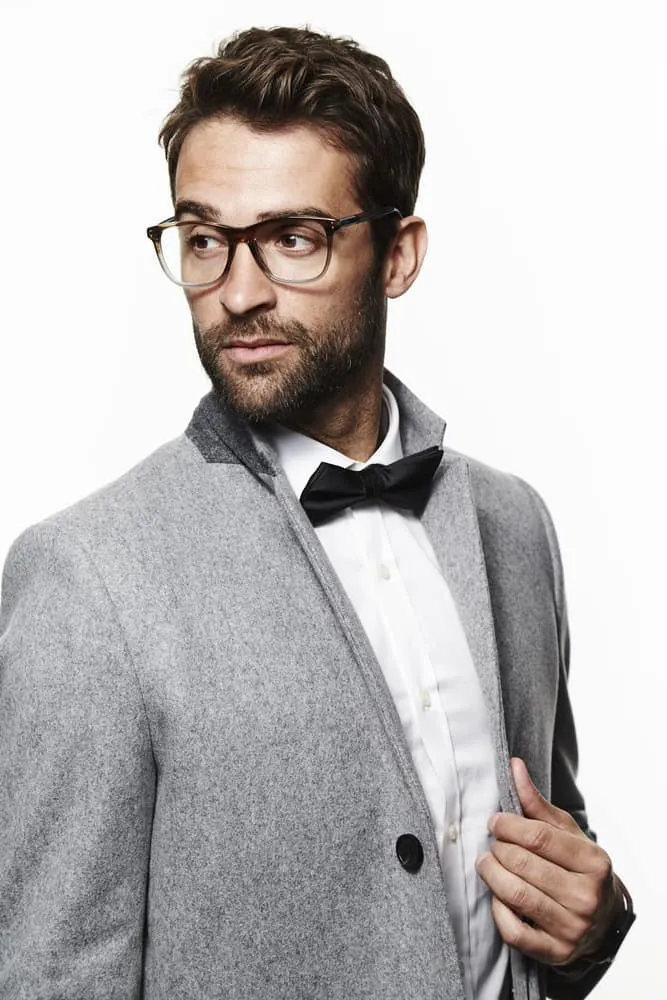This beard length is pretty popular and for good reason. It’s short, yet noticeable. It’s also pretty easy to maintain. You’re about to learn exactly what to expect when you trim your beard with a number 3 clipper guard.
What length it is, what it looks like, and how to trim it.
Let’s get to it.
What Length Is A Number 3 Beard?
The number 3 beard is 10mm long (⅜ inch) and can be trimmed using the #3 clipper guard.
It’s pretty unusual to refer to beards by their “number” because this is a grading system usually used to label haircuts by length.
The number simply refers to the length guard used to trim the haircut using a pair of clippers.
A clipper’s number 3 length guard will trim down to 10mm.
Unlike hair clippers, beard trimmers don’t usually come with numbered length guards. Instead, you’ll simply have guards that tell you exactly how short it’ll trim down to, or you’ll have an adjustable blade.
For example, it’ll simply say “10mm” instead of giving you a number.
Because beards this short are usually trimmed using beard trimmers and not clippers, it’s less common to refer to them by number.
However, it’s definitely possible to trim a beard using the number 3 length guard of a clipper. It’ll trim down to 10mm, just like the “10mm” length guard of a beard trimmer would.
While using a beard trimmer would give you more control than a hair clipper would, it’s definitely acceptable to use a hair clipper when you’re simply looking for a rough-and-ready beard trim.
I’ve written more about using hair clippers on your beard if you’re interested.
What Does A Number 3 Beard Look Like?
A number 3 beard looks like this:

As you can see, it’s long enough to easily be labeled a “short beard” and not just heavy stubble.
It’s the length you could expect after around 3 weeks of growth.
A number 3 beard has its benefits, as well as a couple of disadvantages.
One of its key benefits is that it’s pretty easy to maintain. It’s just about long enough to benefit from beard brushing, but other than that you won’t really have to concern yourself with grooming duties.
Oiling, balming, combing – they aren’t usually necessary just yet.
Trimming is also pretty straightforward – I’ll talk through some of the specifics in the next section.
But overall, you’ll only really need to trim every 2 to 3 days to really maintain a number 3 beard length without allowing it to get untidy.
What about the downsides of the number 3 beard length?
One of its main disadvantages is that patchiness can still be an issue.
It’s still considered a very short beard – so short that those pesky areas of patchiness really haven’t had much of a chance to fill in yet.
The cheeks are notoriously patchy areas of growth. It can be tough to know what to do with them at times.
Often, however, the best option is to grow it out longer. Patchiness sometimes fills itself out as the beard grows longer.
If, however, you’re looking to maintain your beard at the number 3 length, the best option would actually be to choose a style that takes the patchiness into account.
For example, if you’ve got patchy cheek hair – consider a goatee. Why? Goatees remove the need for cheek hair altogether as you’ll be shaving it all off in any case.
Goatees that are a #3 length can look great.
Great Number 3 Beard Styles
Here are a few great number 3 beard styles to inspire you.
1. Classic Number 3 Beard
A classic short beard will have hair on the chin, cheeks, and mustache. It’s what most people think of when they hear the term “beard”.

It’s tough to go wrong with a classic number 3 beard.
However, those with patchy cheek hair will have it on full show and this can be pretty frustrating for some.
They may be better off with one of the next two styles instead.
2. Number 3 Goatee
A goatee can easily be sculpted from a number 3 beard length.

Goatees are great for people with patchy cheek hair because there is no cheek hair. It’s all shaved off.
However, you’ll probably find it tough to trim a goatee with just a hair clipper.
The narrow blade of a beard trimmer with its narrowly-spaced teeth comes in handy when trying to craft more intricate beard styles such as these.
In addition, you’ll need to use a manual razor or an electric shaver to remove the cheek hair and really produce a clean finish.
3. Number 3 Goatee + Chinstrap
A “goatee with a chinstrap” is a combination of two distinct styles – a goatee and a chinstrap.

The goatee is the previous style you saw – hair on the chin but not on the cheeks. Most modern goatees have hair that encircles the mouth – a “full” goatee.
But the bottom line is that there has to be hair on the chin but not on the cheeks.
The chinstrap is a strap of hair that extends along the jawline from one ear to the other. On its own, the chinstrap doesn’t have the best of reputations.
However, when combined with a full goatee like in the picture above, it can produce a great end result.
Once again, it’s a great style to consider when you’re working with a number 3 beard length.
How To Trim And Shave A Number 3 Beard
Here’s a quick, step-by-step tutorial on trimming a simple, classic number 3 beard.
If you’re using a pair of clippers, you’ll need one with a #3 guard – even the budget ones should have this length available.
If, however, you’re using a beard trimmer (a wiser choice), you’ll need one capable of trimming down to 10mm (or near enough to that).
1. Grow It Out For 4 Weeks
When you’re looking to trim down to a number 3 length, you’ll need to have hair that’s long enough to do it in the first place.
Trying to trim a number 3 beard after a single week of growth is going to be pointless. It’ll simply be too short.
4 weeks is a good amount of time to leave before you attempt to trim it because most people will usually have around half an inch (12-13mm) of growth at this point.
You’ll then be able to trim down to a number 3 length (10mm) with ease.
2. Trim And Consider Varying The Length
There are plenty of videos and tutorials on trimming a beard out there already, so I won’t go into too much detail here.
Instead, I’ll run through some practical tips on doing it to get the best results.
Firstly, ensure your clipper or trimmer is charged, cleaned, and oiled.
Next, pop on that number 3 clipper guard (or set the beard trimmer to 10mm) and get ready to trim.
You can start trimming wherever you want but make sure you give equal attention to the three main areas – the cheeks, mustache area, and neck.
Trim against the grain to get an efficient and even trim.
The trouble with hair clippers is that they’re large and difficult to maneuver around the tight edges of a short beard.
So, take extra care to make sure you’re not missing any areas.
At this point, you can consider varying the length a little. This is especially useful if the beard is patchy in areas because trimming the thicker areas slightly shorter than the patchy areas can make a beard look fuller as a whole.
Now, when I say “shorter”, I really do mean a millimeter at a maximum.
The problem with using hair clippers is that you really don’t have this level of control. If you wanted to go shorter with hair clippers, you’re stuck with a number 2 clipper guard which would be a whole 3-4mm shorter.
So, ignore this if you’ve got hair clippers. If you’ve got a beard trimmer, however, and you’ve got the option of trimming the thicker areas a millimeter shorter – strongly consider it.
3. Define The Borders
Now that you’ve trimmed your entire beard to a number 3 length, it’s time to sharpen things up and really define the borders.
These borders are the neckline and the cheek lines.
The neckline is where the neck hair meets the neck. It needs to be set at the correct height and should be well-defined.
A poorly-defined neckline is pretty obvious. An absent neckline is when you’ve simply got neck stubble crawling toward your chest, leading to the dreaded “neckbeard” appearance.
This is never a good look.
The neckline should be approximately two finger-widths above the Adam’s Apple and should vaguely follow the angle of the jawline on either side.
Setting it at this height should ensure that it isn’t too low or too high – both of which can look equally as bad.
The cheek lines aren’t as important to define, especially when the hair is this short.
You could very reasonably leave them au naturale and not touch them at all.
Conclusion
There you have it. Hopefully, everything you could ever want to know about the number 3 beard.
How long it is, what it looks like, and more.
Enjoy.
Ready Sleek founder. Obsessed with casual style and the minimalist approach to building a highly functional wardrobe. Also a fan of classic, vintage hairstyles.







